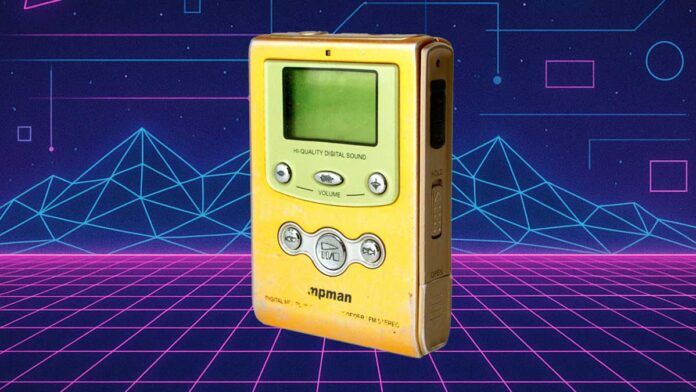In the late 1990s, the idea of carrying dozens of songs in your pocket felt like science fiction. Yet a handful of manufacturers set out to make it real. Their creations ranged from clunky flash‑based curiosities to hard‑drive behemoths that looked more like portable CD players. Though most people today jump straight to the iPod, these pioneers deserve a closer look.
MPMan F10
Ask any hardcore gadget historian about the first portable MP3 player, and the answer isn’t Apple. It’s SaeHan Information Systems’ MPMan F10, released in Asia in 1998. This pocket‑sized device came with just 32 MB of flash memory, enough for about six songs, and owners who wanted more storage had to mail it back to Eiger Labs with a cheque to upgrade it to 64 MB. To load music, you plugged a docking station into a parallel port, a setup that seems clumsy today but felt revolutionary at the time.
Diamond Rio PMP300
Perhaps the first digital player to break into mainstream awareness was Diamond Multimedia’s Rio PMP300. Introduced in September 1998, it looked like a deck of cards and offered 32 MB of internal memory plus a SmartMedia slot for expansion. It used a single AA battery for eight to twelve hours of playback and connected via a parallel port, and it cost around US $200. The Rio’s notoriety grew when the Recording Industry Association of America sued Diamond, alleging the device encouraged piracy. A judge ruled in the company’s favour, paving the way for portable digital players to flourish.
Sensory Science Rave MP2100
You may not have heard of the Rave MP2100, and that’s part of its charm. This Sensory Science device held about 64 MB of music and was one of several flash‑based players that could only store seven to twenty songs. Like many of its peers, it relied on a parallel connection and proprietary software. Today, it exists mainly as a trivia question for early adopters.
I‑Jam IJ‑100
Another forgotten name, the I‑Jam IJ‑100, joined the Rave on store shelves around the same time. Its claim to fame? An even slimmer profile and a marketing campaign aimed at style‑conscious teens. Storage was still minuscule by modern standards; you were lucky to squeeze a full album on the thing.
Compaq Personal Jukebox (PJB‑100)
Flash memory was expensive, so some manufacturers turned to laptop hard drives. Compaq and Hango Electronics released the Personal Jukebox (PJB‑100) in 1999 with a 4.8 GB drive that could store around 1,200 songs. It weighed nearly a pound, ran on rechargeable batteries, and introduced the “jukebox” segment of digital music players, which later inspired the iPod.
Creative Nomad Jukebox
The following year Creative Labs jumped into the market with the Nomad Jukebox. Imagine a CD Discman stuffed with a 6 GB hard drive that held over 100 hours of music. Reviewers loved the capacity and sound quality but mocked the size and weight. It ran on four AA batteries and connected via USB, which made it easier to load songs than its parallel‑port competitors.
Archos Jukebox 6000
French company Archos built on Creative’s idea with its own Jukebox 6000. This unit featured a 6 GB 2.5‑inch hard drive and allowed users to copy files directly onto it without special software. Users could even swap in larger drives using a standard IDE interface. The Jukebox inspired a group of hobbyists to write an open‑source firmware called Rockbox when they became frustrated with the original software.
Empeg Car / Rio Car
Not all MP3 players were handheld. Empeg’s in‑dash MP3 player launched around the turn of the millennium with capacities from 5 GB to 28 GB. Renamed the Rio Car after Diamond acquired it, the unit let drivers load a huge digital library into their car stereo. It was ahead of its time and too expensive, leading to discontinuation in 2001.
Sony’s Vaio Music Clip and Memory Stick Walkman
Sony dominated portable music with the Walkman, yet its first digital efforts were oddly reluctant to embrace MP3. The company’s Vaio Music Clip and Memory Stick Walkman, released in 1999, used proprietary ATRAC and WMA formats. Sony didn’t ship an MP3‑compatible Walkman until 2004, which meant its early digital players remain curiosities for collectors.
Looking Back
From the tiny MPMan to chunky jukeboxes and in‑car systems, early MP3 players were a mixed bag. They were expensive, underpowered, and sometimes awkward to use. Yet each device pushed digital music closer to the mainstream. Without them, we might never have seen sleek players like the iPod, and we certainly wouldn’t have the streaming‑centric world of today. For vintage tech enthusiasts, these gadgets are more than relics; they’re the stepping stones that built our digital soundscape.

